Routine Observation for Mental Health Improvement
VerifiedAdded on 2020/10/23
|8
|2605
|320
AI Summary
This report explores the significance of routine observation in enhancing mental health, particularly for patients struggling with depression or other mental illnesses. It emphasizes the importance of kindness, stress management, and yoga practices in improving patient well-being. The study also touches upon the role of social work and partnership working in health care. Overall, it highlights the value of routine observation in promoting positive outcomes for individuals with mental health issues.
Contribute Materials
Your contribution can guide someone’s learning journey. Share your
documents today.
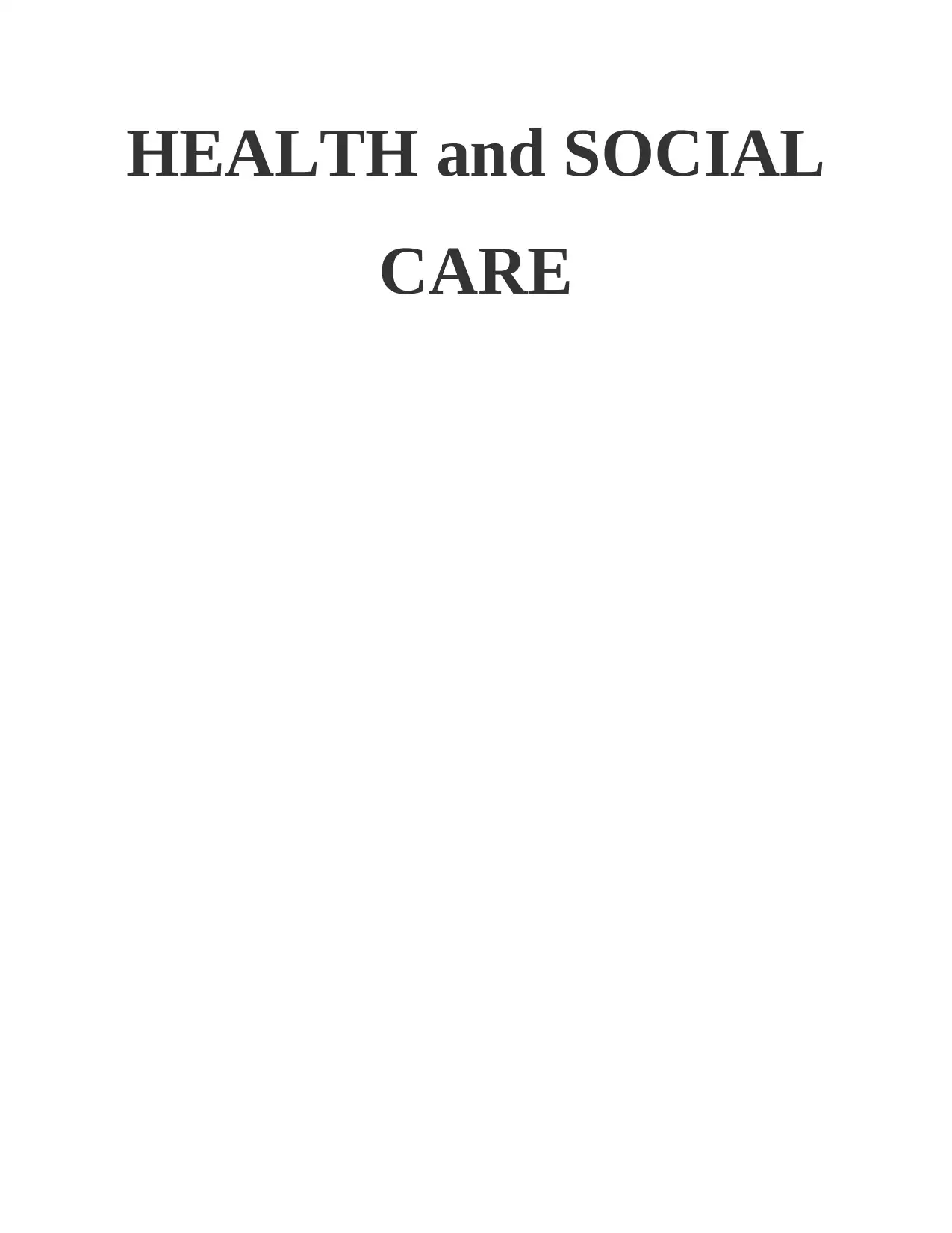
HEALTH and SOCIAL
CARE
CARE
Secure Best Marks with AI Grader
Need help grading? Try our AI Grader for instant feedback on your assignments.

Table of Contents
INTRODUCTION...........................................................................................................................1
MAIN BODY...................................................................................................................................1
Question 1. Routine observation which can be used to support care. ........................................1
Question 2. Explain the impact of three common disorders on the major body system. ...........2
Question 3. Discuss the routine care given to individual suffering from mental disorder. ........4
Question 4. Recommendation and Justification. ........................................................................4
CONCLUSION................................................................................................................................5
REFERENCES................................................................................................................................6
INTRODUCTION...........................................................................................................................1
MAIN BODY...................................................................................................................................1
Question 1. Routine observation which can be used to support care. ........................................1
Question 2. Explain the impact of three common disorders on the major body system. ...........2
Question 3. Discuss the routine care given to individual suffering from mental disorder. ........4
Question 4. Recommendation and Justification. ........................................................................4
CONCLUSION................................................................................................................................5
REFERENCES................................................................................................................................6
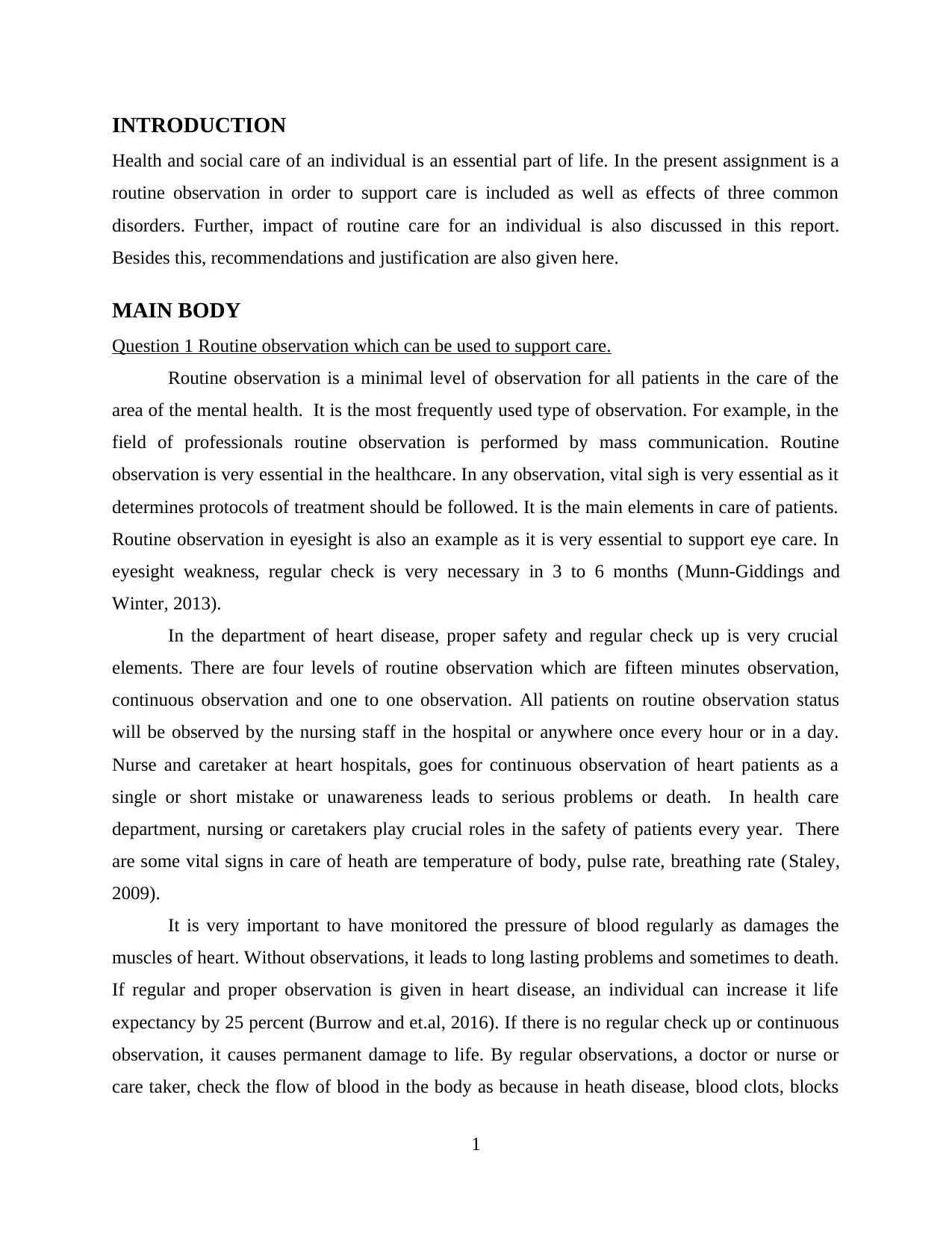
INTRODUCTION
Health and social care of an individual is an essential part of life. In the present assignment is a
routine observation in order to support care is included as well as effects of three common
disorders. Further, impact of routine care for an individual is also discussed in this report.
Besides this, recommendations and justification are also given here.
MAIN BODY
Question 1 Routine observation which can be used to support care.
Routine observation is a minimal level of observation for all patients in the care of the
area of the mental health. It is the most frequently used type of observation. For example, in the
field of professionals routine observation is performed by mass communication. Routine
observation is very essential in the healthcare. In any observation, vital sigh is very essential as it
determines protocols of treatment should be followed. It is the main elements in care of patients.
Routine observation in eyesight is also an example as it is very essential to support eye care. In
eyesight weakness, regular check is very necessary in 3 to 6 months (Munn-Giddings and
Winter, 2013).
In the department of heart disease, proper safety and regular check up is very crucial
elements. There are four levels of routine observation which are fifteen minutes observation,
continuous observation and one to one observation. All patients on routine observation status
will be observed by the nursing staff in the hospital or anywhere once every hour or in a day.
Nurse and caretaker at heart hospitals, goes for continuous observation of heart patients as a
single or short mistake or unawareness leads to serious problems or death. In health care
department, nursing or caretakers play crucial roles in the safety of patients every year. There
are some vital signs in care of heath are temperature of body, pulse rate, breathing rate (Staley,
2009).
It is very important to have monitored the pressure of blood regularly as damages the
muscles of heart. Without observations, it leads to long lasting problems and sometimes to death.
If regular and proper observation is given in heart disease, an individual can increase it life
expectancy by 25 percent (Burrow and et.al, 2016). If there is no regular check up or continuous
observation, it causes permanent damage to life. By regular observations, a doctor or nurse or
care taker, check the flow of blood in the body as because in heath disease, blood clots, blocks
1
Health and social care of an individual is an essential part of life. In the present assignment is a
routine observation in order to support care is included as well as effects of three common
disorders. Further, impact of routine care for an individual is also discussed in this report.
Besides this, recommendations and justification are also given here.
MAIN BODY
Question 1 Routine observation which can be used to support care.
Routine observation is a minimal level of observation for all patients in the care of the
area of the mental health. It is the most frequently used type of observation. For example, in the
field of professionals routine observation is performed by mass communication. Routine
observation is very essential in the healthcare. In any observation, vital sigh is very essential as it
determines protocols of treatment should be followed. It is the main elements in care of patients.
Routine observation in eyesight is also an example as it is very essential to support eye care. In
eyesight weakness, regular check is very necessary in 3 to 6 months (Munn-Giddings and
Winter, 2013).
In the department of heart disease, proper safety and regular check up is very crucial
elements. There are four levels of routine observation which are fifteen minutes observation,
continuous observation and one to one observation. All patients on routine observation status
will be observed by the nursing staff in the hospital or anywhere once every hour or in a day.
Nurse and caretaker at heart hospitals, goes for continuous observation of heart patients as a
single or short mistake or unawareness leads to serious problems or death. In health care
department, nursing or caretakers play crucial roles in the safety of patients every year. There
are some vital signs in care of heath are temperature of body, pulse rate, breathing rate (Staley,
2009).
It is very important to have monitored the pressure of blood regularly as damages the
muscles of heart. Without observations, it leads to long lasting problems and sometimes to death.
If regular and proper observation is given in heart disease, an individual can increase it life
expectancy by 25 percent (Burrow and et.al, 2016). If there is no regular check up or continuous
observation, it causes permanent damage to life. By regular observations, a doctor or nurse or
care taker, check the flow of blood in the body as because in heath disease, blood clots, blocks
1
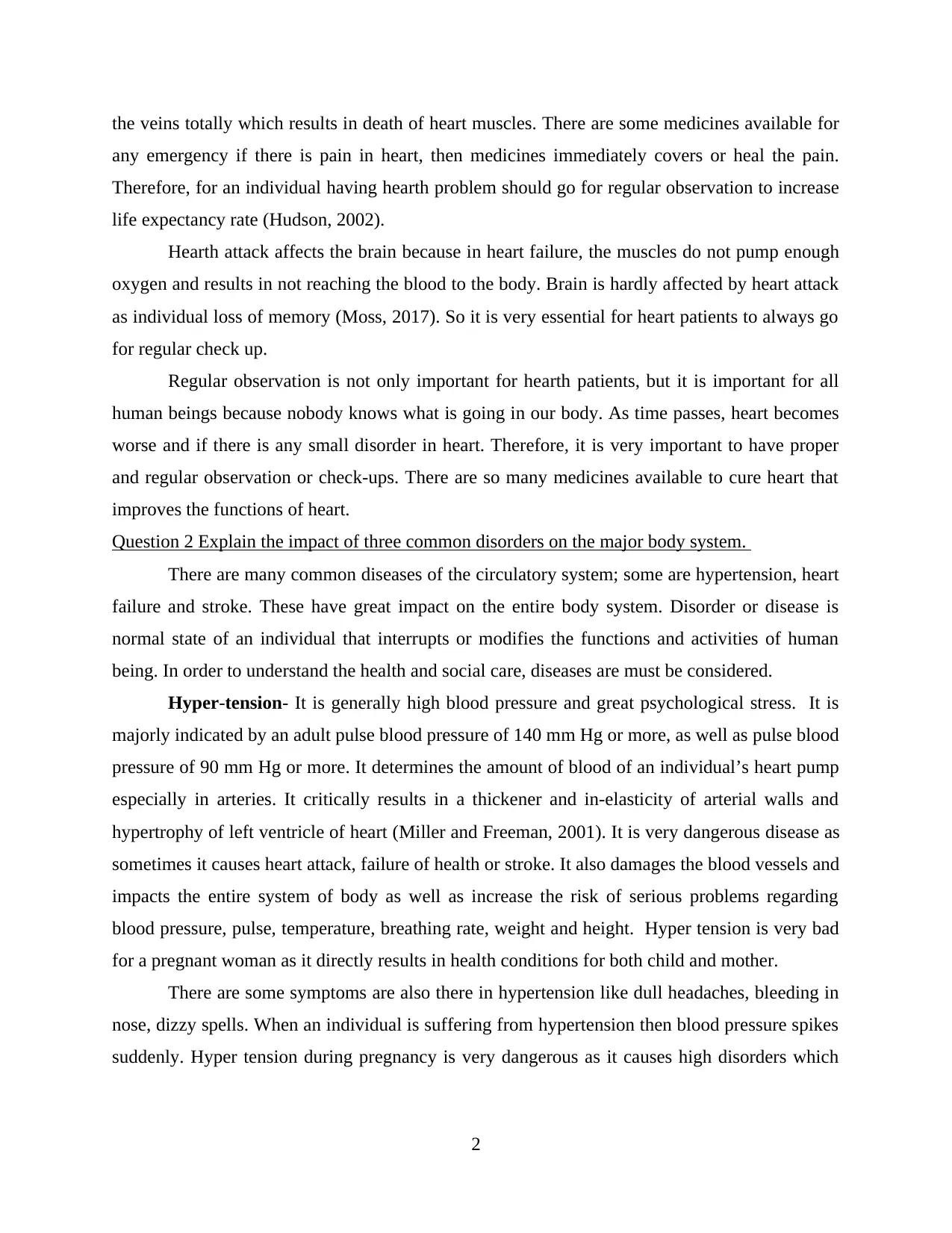
the veins totally which results in death of heart muscles. There are some medicines available for
any emergency if there is pain in heart, then medicines immediately covers or heal the pain.
Therefore, for an individual having hearth problem should go for regular observation to increase
life expectancy rate (Hudson, 2002).
Hearth attack affects the brain because in heart failure, the muscles do not pump enough
oxygen and results in not reaching the blood to the body. Brain is hardly affected by heart attack
as individual loss of memory (Moss, 2017). So it is very essential for heart patients to always go
for regular check up.
Regular observation is not only important for hearth patients, but it is important for all
human beings because nobody knows what is going in our body. As time passes, heart becomes
worse and if there is any small disorder in heart. Therefore, it is very important to have proper
and regular observation or check-ups. There are so many medicines available to cure heart that
improves the functions of heart.
Question 2 Explain the impact of three common disorders on the major body system.
There are many common diseases of the circulatory system; some are hypertension, heart
failure and stroke. These have great impact on the entire body system. Disorder or disease is
normal state of an individual that interrupts or modifies the functions and activities of human
being. In order to understand the health and social care, diseases are must be considered.
Hyper-tension- It is generally high blood pressure and great psychological stress. It is
majorly indicated by an adult pulse blood pressure of 140 mm Hg or more, as well as pulse blood
pressure of 90 mm Hg or more. It determines the amount of blood of an individual’s heart pump
especially in arteries. It critically results in a thickener and in-elasticity of arterial walls and
hypertrophy of left ventricle of heart (Miller and Freeman, 2001). It is very dangerous disease as
sometimes it causes heart attack, failure of health or stroke. It also damages the blood vessels and
impacts the entire system of body as well as increase the risk of serious problems regarding
blood pressure, pulse, temperature, breathing rate, weight and height. Hyper tension is very bad
for a pregnant woman as it directly results in health conditions for both child and mother.
There are some symptoms are also there in hypertension like dull headaches, bleeding in
nose, dizzy spells. When an individual is suffering from hypertension then blood pressure spikes
suddenly. Hyper tension during pregnancy is very dangerous as it causes high disorders which
2
any emergency if there is pain in heart, then medicines immediately covers or heal the pain.
Therefore, for an individual having hearth problem should go for regular observation to increase
life expectancy rate (Hudson, 2002).
Hearth attack affects the brain because in heart failure, the muscles do not pump enough
oxygen and results in not reaching the blood to the body. Brain is hardly affected by heart attack
as individual loss of memory (Moss, 2017). So it is very essential for heart patients to always go
for regular check up.
Regular observation is not only important for hearth patients, but it is important for all
human beings because nobody knows what is going in our body. As time passes, heart becomes
worse and if there is any small disorder in heart. Therefore, it is very important to have proper
and regular observation or check-ups. There are so many medicines available to cure heart that
improves the functions of heart.
Question 2 Explain the impact of three common disorders on the major body system.
There are many common diseases of the circulatory system; some are hypertension, heart
failure and stroke. These have great impact on the entire body system. Disorder or disease is
normal state of an individual that interrupts or modifies the functions and activities of human
being. In order to understand the health and social care, diseases are must be considered.
Hyper-tension- It is generally high blood pressure and great psychological stress. It is
majorly indicated by an adult pulse blood pressure of 140 mm Hg or more, as well as pulse blood
pressure of 90 mm Hg or more. It determines the amount of blood of an individual’s heart pump
especially in arteries. It critically results in a thickener and in-elasticity of arterial walls and
hypertrophy of left ventricle of heart (Miller and Freeman, 2001). It is very dangerous disease as
sometimes it causes heart attack, failure of health or stroke. It also damages the blood vessels and
impacts the entire system of body as well as increase the risk of serious problems regarding
blood pressure, pulse, temperature, breathing rate, weight and height. Hyper tension is very bad
for a pregnant woman as it directly results in health conditions for both child and mother.
There are some symptoms are also there in hypertension like dull headaches, bleeding in
nose, dizzy spells. When an individual is suffering from hypertension then blood pressure spikes
suddenly. Hyper tension during pregnancy is very dangerous as it causes high disorders which
2
Secure Best Marks with AI Grader
Need help grading? Try our AI Grader for instant feedback on your assignments.
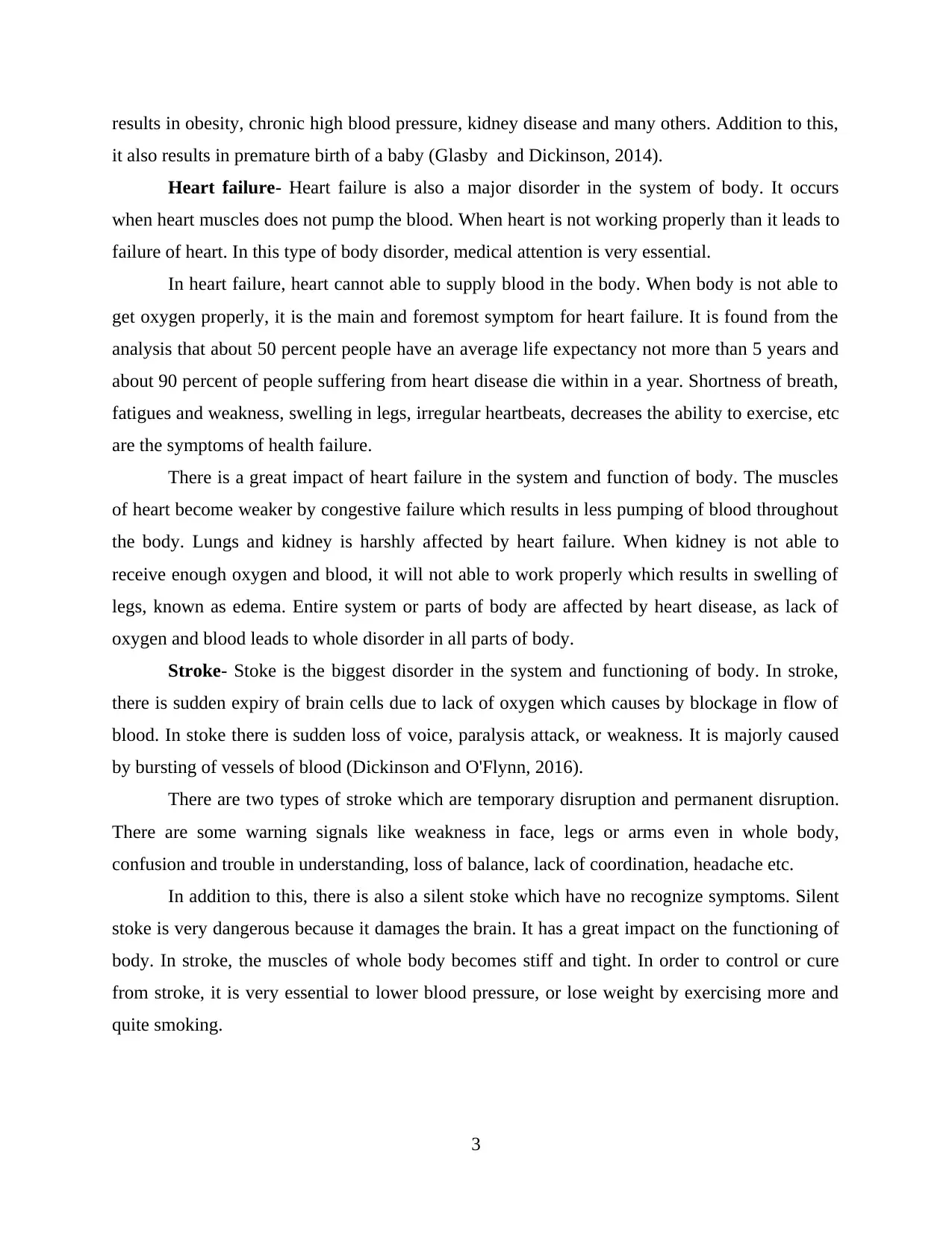
results in obesity, chronic high blood pressure, kidney disease and many others. Addition to this,
it also results in premature birth of a baby (Glasby and Dickinson, 2014).
Heart failure- Heart failure is also a major disorder in the system of body. It occurs
when heart muscles does not pump the blood. When heart is not working properly than it leads to
failure of heart. In this type of body disorder, medical attention is very essential.
In heart failure, heart cannot able to supply blood in the body. When body is not able to
get oxygen properly, it is the main and foremost symptom for heart failure. It is found from the
analysis that about 50 percent people have an average life expectancy not more than 5 years and
about 90 percent of people suffering from heart disease die within in a year. Shortness of breath,
fatigues and weakness, swelling in legs, irregular heartbeats, decreases the ability to exercise, etc
are the symptoms of health failure.
There is a great impact of heart failure in the system and function of body. The muscles
of heart become weaker by congestive failure which results in less pumping of blood throughout
the body. Lungs and kidney is harshly affected by heart failure. When kidney is not able to
receive enough oxygen and blood, it will not able to work properly which results in swelling of
legs, known as edema. Entire system or parts of body are affected by heart disease, as lack of
oxygen and blood leads to whole disorder in all parts of body.
Stroke- Stoke is the biggest disorder in the system and functioning of body. In stroke,
there is sudden expiry of brain cells due to lack of oxygen which causes by blockage in flow of
blood. In stoke there is sudden loss of voice, paralysis attack, or weakness. It is majorly caused
by bursting of vessels of blood (Dickinson and O'Flynn, 2016).
There are two types of stroke which are temporary disruption and permanent disruption.
There are some warning signals like weakness in face, legs or arms even in whole body,
confusion and trouble in understanding, loss of balance, lack of coordination, headache etc.
In addition to this, there is also a silent stoke which have no recognize symptoms. Silent
stoke is very dangerous because it damages the brain. It has a great impact on the functioning of
body. In stroke, the muscles of whole body becomes stiff and tight. In order to control or cure
from stroke, it is very essential to lower blood pressure, or lose weight by exercising more and
quite smoking.
3
it also results in premature birth of a baby (Glasby and Dickinson, 2014).
Heart failure- Heart failure is also a major disorder in the system of body. It occurs
when heart muscles does not pump the blood. When heart is not working properly than it leads to
failure of heart. In this type of body disorder, medical attention is very essential.
In heart failure, heart cannot able to supply blood in the body. When body is not able to
get oxygen properly, it is the main and foremost symptom for heart failure. It is found from the
analysis that about 50 percent people have an average life expectancy not more than 5 years and
about 90 percent of people suffering from heart disease die within in a year. Shortness of breath,
fatigues and weakness, swelling in legs, irregular heartbeats, decreases the ability to exercise, etc
are the symptoms of health failure.
There is a great impact of heart failure in the system and function of body. The muscles
of heart become weaker by congestive failure which results in less pumping of blood throughout
the body. Lungs and kidney is harshly affected by heart failure. When kidney is not able to
receive enough oxygen and blood, it will not able to work properly which results in swelling of
legs, known as edema. Entire system or parts of body are affected by heart disease, as lack of
oxygen and blood leads to whole disorder in all parts of body.
Stroke- Stoke is the biggest disorder in the system and functioning of body. In stroke,
there is sudden expiry of brain cells due to lack of oxygen which causes by blockage in flow of
blood. In stoke there is sudden loss of voice, paralysis attack, or weakness. It is majorly caused
by bursting of vessels of blood (Dickinson and O'Flynn, 2016).
There are two types of stroke which are temporary disruption and permanent disruption.
There are some warning signals like weakness in face, legs or arms even in whole body,
confusion and trouble in understanding, loss of balance, lack of coordination, headache etc.
In addition to this, there is also a silent stoke which have no recognize symptoms. Silent
stoke is very dangerous because it damages the brain. It has a great impact on the functioning of
body. In stroke, the muscles of whole body becomes stiff and tight. In order to control or cure
from stroke, it is very essential to lower blood pressure, or lose weight by exercising more and
quite smoking.
3
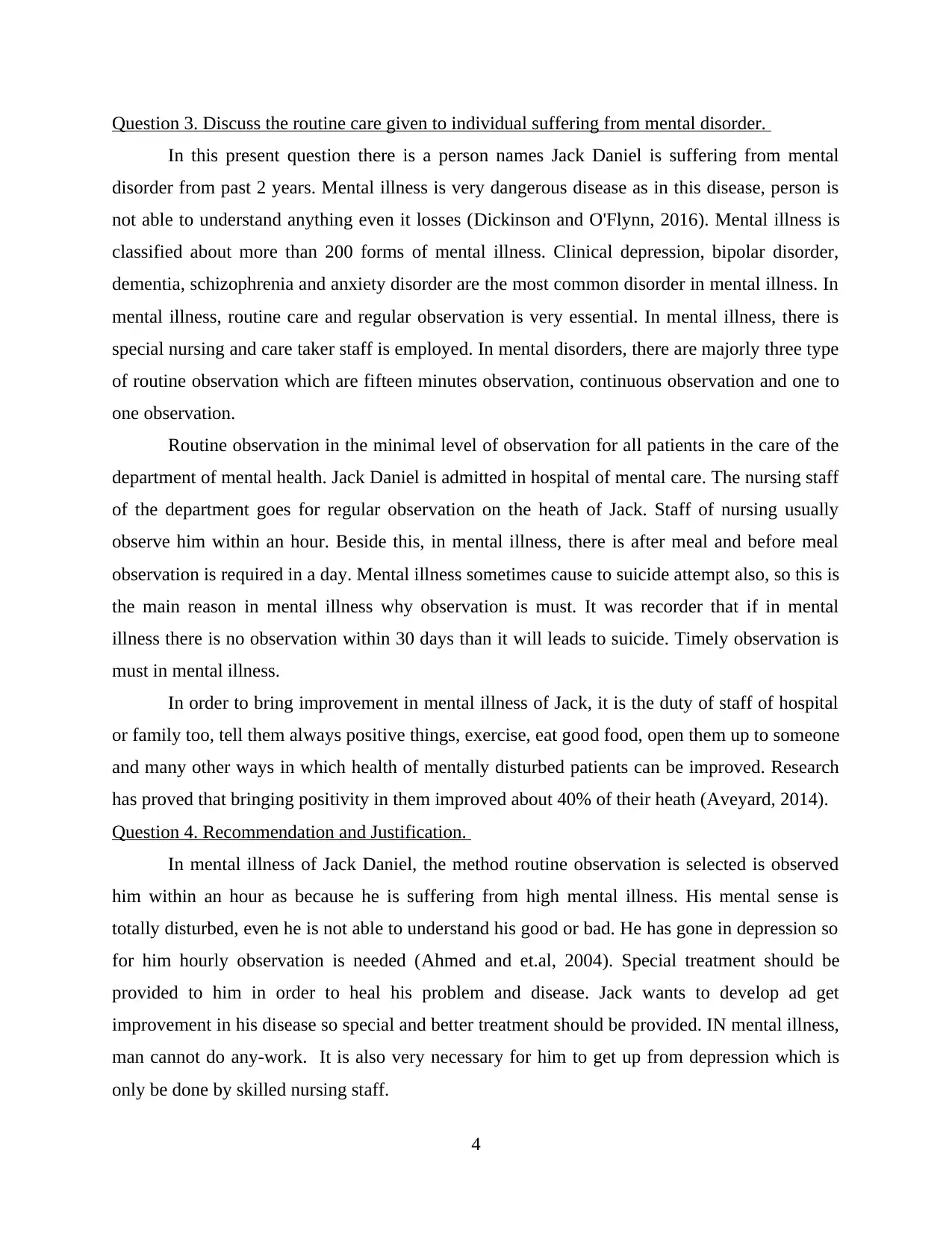
Question 3. Discuss the routine care given to individual suffering from mental disorder.
In this present question there is a person names Jack Daniel is suffering from mental
disorder from past 2 years. Mental illness is very dangerous disease as in this disease, person is
not able to understand anything even it losses (Dickinson and O'Flynn, 2016). Mental illness is
classified about more than 200 forms of mental illness. Clinical depression, bipolar disorder,
dementia, schizophrenia and anxiety disorder are the most common disorder in mental illness. In
mental illness, routine care and regular observation is very essential. In mental illness, there is
special nursing and care taker staff is employed. In mental disorders, there are majorly three type
of routine observation which are fifteen minutes observation, continuous observation and one to
one observation.
Routine observation in the minimal level of observation for all patients in the care of the
department of mental health. Jack Daniel is admitted in hospital of mental care. The nursing staff
of the department goes for regular observation on the heath of Jack. Staff of nursing usually
observe him within an hour. Beside this, in mental illness, there is after meal and before meal
observation is required in a day. Mental illness sometimes cause to suicide attempt also, so this is
the main reason in mental illness why observation is must. It was recorder that if in mental
illness there is no observation within 30 days than it will leads to suicide. Timely observation is
must in mental illness.
In order to bring improvement in mental illness of Jack, it is the duty of staff of hospital
or family too, tell them always positive things, exercise, eat good food, open them up to someone
and many other ways in which health of mentally disturbed patients can be improved. Research
has proved that bringing positivity in them improved about 40% of their heath (Aveyard, 2014).
Question 4. Recommendation and Justification.
In mental illness of Jack Daniel, the method routine observation is selected is observed
him within an hour as because he is suffering from high mental illness. His mental sense is
totally disturbed, even he is not able to understand his good or bad. He has gone in depression so
for him hourly observation is needed (Ahmed and et.al, 2004). Special treatment should be
provided to him in order to heal his problem and disease. Jack wants to develop ad get
improvement in his disease so special and better treatment should be provided. IN mental illness,
man cannot do any-work. It is also very necessary for him to get up from depression which is
only be done by skilled nursing staff.
4
In this present question there is a person names Jack Daniel is suffering from mental
disorder from past 2 years. Mental illness is very dangerous disease as in this disease, person is
not able to understand anything even it losses (Dickinson and O'Flynn, 2016). Mental illness is
classified about more than 200 forms of mental illness. Clinical depression, bipolar disorder,
dementia, schizophrenia and anxiety disorder are the most common disorder in mental illness. In
mental illness, routine care and regular observation is very essential. In mental illness, there is
special nursing and care taker staff is employed. In mental disorders, there are majorly three type
of routine observation which are fifteen minutes observation, continuous observation and one to
one observation.
Routine observation in the minimal level of observation for all patients in the care of the
department of mental health. Jack Daniel is admitted in hospital of mental care. The nursing staff
of the department goes for regular observation on the heath of Jack. Staff of nursing usually
observe him within an hour. Beside this, in mental illness, there is after meal and before meal
observation is required in a day. Mental illness sometimes cause to suicide attempt also, so this is
the main reason in mental illness why observation is must. It was recorder that if in mental
illness there is no observation within 30 days than it will leads to suicide. Timely observation is
must in mental illness.
In order to bring improvement in mental illness of Jack, it is the duty of staff of hospital
or family too, tell them always positive things, exercise, eat good food, open them up to someone
and many other ways in which health of mentally disturbed patients can be improved. Research
has proved that bringing positivity in them improved about 40% of their heath (Aveyard, 2014).
Question 4. Recommendation and Justification.
In mental illness of Jack Daniel, the method routine observation is selected is observed
him within an hour as because he is suffering from high mental illness. His mental sense is
totally disturbed, even he is not able to understand his good or bad. He has gone in depression so
for him hourly observation is needed (Ahmed and et.al, 2004). Special treatment should be
provided to him in order to heal his problem and disease. Jack wants to develop ad get
improvement in his disease so special and better treatment should be provided. IN mental illness,
man cannot do any-work. It is also very necessary for him to get up from depression which is
only be done by skilled nursing staff.
4

Further mental promotion programmes should be organized which results in mental
improvement of Jack and others as well. In order to ensure the accessibility and availability of
minimum care of health for all and to promote the application of mental health knowledge in
development of social and health care, mental heath programme is very fruitful. This
programmes also boost society participation in development of mental heath services.
In the mental illness of Jack, we have chosen hourly observation because he is suffering
from this illness for past 2 years and now he has gone in depression. In order to safe and protect
Jack from going in Coma, hourly observation is must for him. Beside this, nursing staff should
increase the strength of patient, treat them with kindness and esteem, allow them to talk or
interact with good people, make them learn how to deal with stress. Another most essential core
factor in improving the mental health of jack is Yoga. Yoga is the best way to make
improvement in his health, staff should conduct yoga practices once in a day. In the hospital of
mental care, there should be positivity in its atmosphere, that patient should have hope of
recovery (Baldwin, 2016).
CONCLUSION
From the above report, it is concluded that routine observation plays a vital role in
improvement of any disease. In this study, heart attack, hyper-tension, stroke as well there
impact is discussed. Routine observation on mental health of a person is also discussed.
Furthermore, recommendation and justification is also understood in this report.
5
improvement of Jack and others as well. In order to ensure the accessibility and availability of
minimum care of health for all and to promote the application of mental health knowledge in
development of social and health care, mental heath programme is very fruitful. This
programmes also boost society participation in development of mental heath services.
In the mental illness of Jack, we have chosen hourly observation because he is suffering
from this illness for past 2 years and now he has gone in depression. In order to safe and protect
Jack from going in Coma, hourly observation is must for him. Beside this, nursing staff should
increase the strength of patient, treat them with kindness and esteem, allow them to talk or
interact with good people, make them learn how to deal with stress. Another most essential core
factor in improving the mental health of jack is Yoga. Yoga is the best way to make
improvement in his health, staff should conduct yoga practices once in a day. In the hospital of
mental care, there should be positivity in its atmosphere, that patient should have hope of
recovery (Baldwin, 2016).
CONCLUSION
From the above report, it is concluded that routine observation plays a vital role in
improvement of any disease. In this study, heart attack, hyper-tension, stroke as well there
impact is discussed. Routine observation on mental health of a person is also discussed.
Furthermore, recommendation and justification is also understood in this report.
5
Paraphrase This Document
Need a fresh take? Get an instant paraphrase of this document with our AI Paraphraser
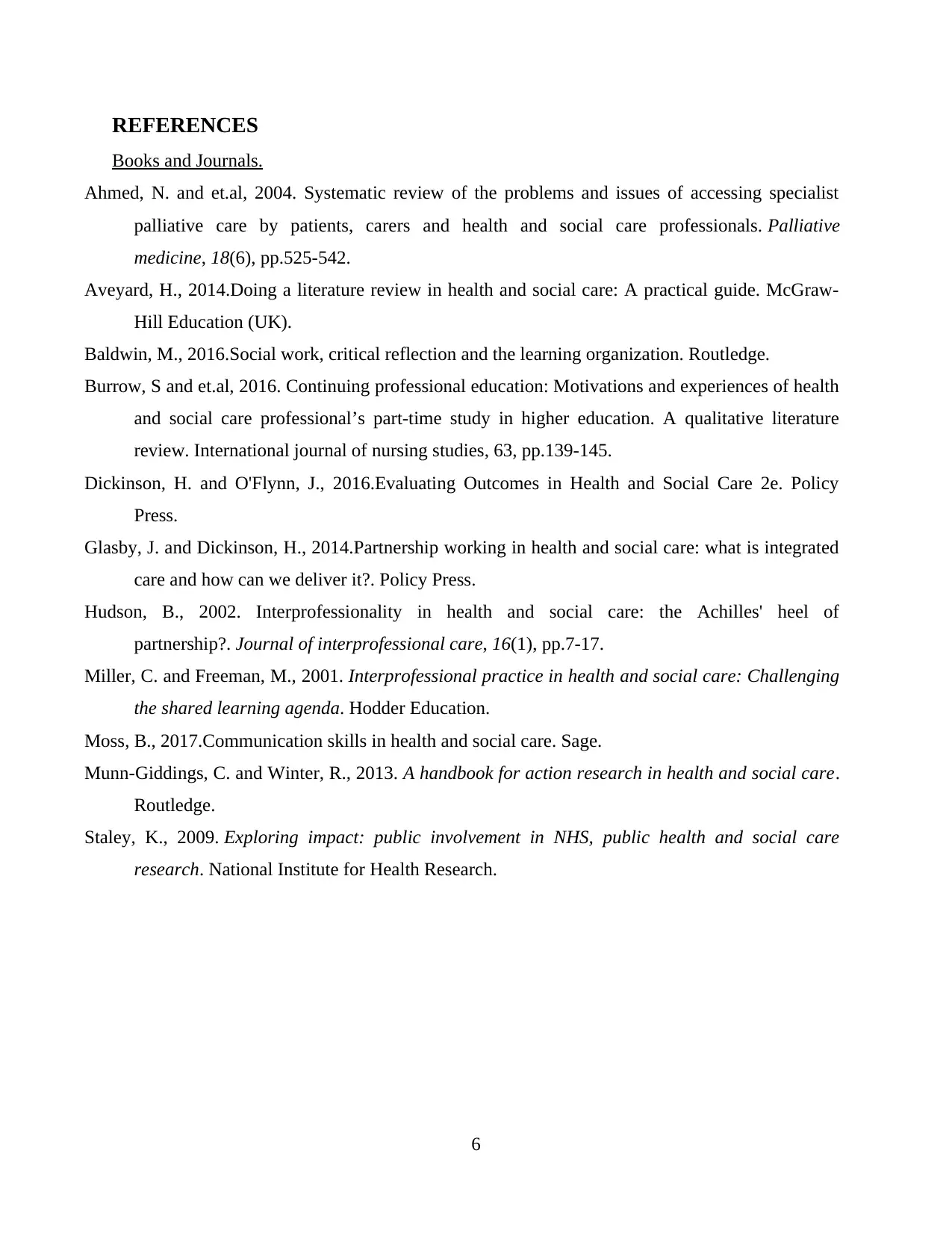
REFERENCES
Books and Journals.
Ahmed, N. and et.al, 2004. Systematic review of the problems and issues of accessing specialist
palliative care by patients, carers and health and social care professionals. Palliative
medicine, 18(6), pp.525-542.
Aveyard, H., 2014.Doing a literature review in health and social care: A practical guide. McGraw-
Hill Education (UK).
Baldwin, M., 2016.Social work, critical reflection and the learning organization. Routledge.
Burrow, S and et.al, 2016. Continuing professional education: Motivations and experiences of health
and social care professional’s part-time study in higher education. A qualitative literature
review. International journal of nursing studies, 63, pp.139-145.
Dickinson, H. and O'Flynn, J., 2016.Evaluating Outcomes in Health and Social Care 2e. Policy
Press.
Glasby, J. and Dickinson, H., 2014.Partnership working in health and social care: what is integrated
care and how can we deliver it?. Policy Press.
Hudson, B., 2002. Interprofessionality in health and social care: the Achilles' heel of
partnership?. Journal of interprofessional care, 16(1), pp.7-17.
Miller, C. and Freeman, M., 2001. Interprofessional practice in health and social care: Challenging
the shared learning agenda. Hodder Education.
Moss, B., 2017.Communication skills in health and social care. Sage.
Munn-Giddings, C. and Winter, R., 2013. A handbook for action research in health and social care.
Routledge.
Staley, K., 2009. Exploring impact: public involvement in NHS, public health and social care
research. National Institute for Health Research.
6
Books and Journals.
Ahmed, N. and et.al, 2004. Systematic review of the problems and issues of accessing specialist
palliative care by patients, carers and health and social care professionals. Palliative
medicine, 18(6), pp.525-542.
Aveyard, H., 2014.Doing a literature review in health and social care: A practical guide. McGraw-
Hill Education (UK).
Baldwin, M., 2016.Social work, critical reflection and the learning organization. Routledge.
Burrow, S and et.al, 2016. Continuing professional education: Motivations and experiences of health
and social care professional’s part-time study in higher education. A qualitative literature
review. International journal of nursing studies, 63, pp.139-145.
Dickinson, H. and O'Flynn, J., 2016.Evaluating Outcomes in Health and Social Care 2e. Policy
Press.
Glasby, J. and Dickinson, H., 2014.Partnership working in health and social care: what is integrated
care and how can we deliver it?. Policy Press.
Hudson, B., 2002. Interprofessionality in health and social care: the Achilles' heel of
partnership?. Journal of interprofessional care, 16(1), pp.7-17.
Miller, C. and Freeman, M., 2001. Interprofessional practice in health and social care: Challenging
the shared learning agenda. Hodder Education.
Moss, B., 2017.Communication skills in health and social care. Sage.
Munn-Giddings, C. and Winter, R., 2013. A handbook for action research in health and social care.
Routledge.
Staley, K., 2009. Exploring impact: public involvement in NHS, public health and social care
research. National Institute for Health Research.
6
1 out of 8
Related Documents
Your All-in-One AI-Powered Toolkit for Academic Success.
+13062052269
info@desklib.com
Available 24*7 on WhatsApp / Email
![[object Object]](/_next/static/media/star-bottom.7253800d.svg)
Unlock your academic potential
© 2024 | Zucol Services PVT LTD | All rights reserved.





